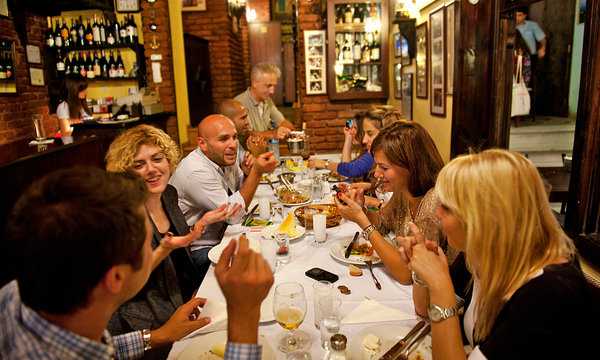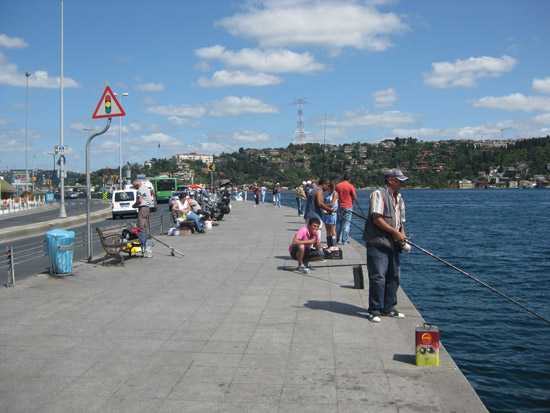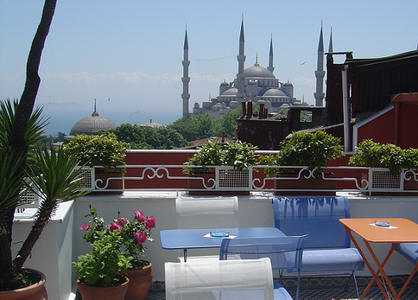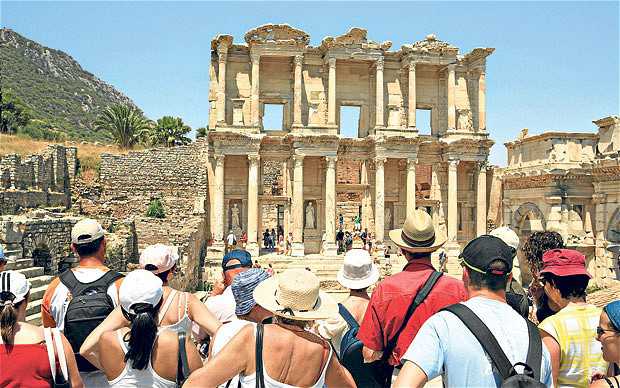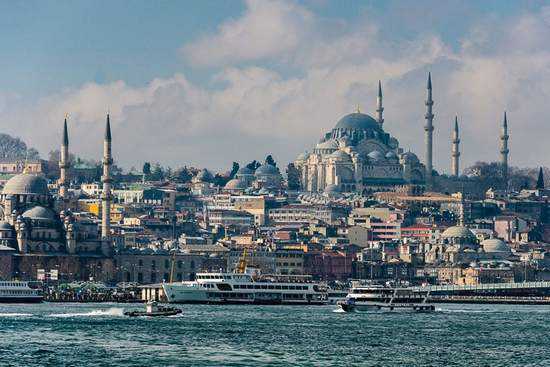The tour ended at Fethiye, the ancient city of Telmessos, where I sat in the Roman amphitheatre watching the local teenagers flirting on its crumbling stone seats overlooking the bay.
To see so many places, famous and not-so-famous, in one week is an unusual opportunity to understand both the continuity of Classical civilisation over a millennium and its decline, due as much to the silting up of rivers and earthquakes as to the fall of the Roman Empire. I could now draw you an identikit map of a Carian-Lycian-Greek-Roman city, with its temples, theatre, agora, harbour, necropolis and plumbing arrangements, and even include the delicate frescoes which decorated its villas, having seen them in situ at Ephesus.
Aphrodisias, with the widely scattered remains of its huge temple, theatre and stadium surrounded by waving poppies and olive trees, was for me the best place from which to make sense of the ruins of the successive civilisations which litter this part of Turkey. Its small museum, displaying and explaining the symbolism of the sculptures found there, is one of the most illuminating I have ever seen.
I am not a museum fan. I’d rather see a crumbling sculpture in its original setting than the best-preserved Classical statue, stripped of its context, in a museum. But the museum at Aphrodisias is exceptional, partly because of the beauty and significance of the site itself, a fertility cult centre since around 9000BC.
The worship of Aphrodite lingered on here well into the fifth century, long after paganism had been eradicated in other parts of the Roman Empire. The museum is state of the art as the site is still being excavated by an American archaeological team, which may explain the clarity and helpfulness of the English explanatory notices alongside the Turkish ones.
Thanks to the display notes, I saw things I would have completely overlooked: an early Classical head of Alexander the Great with a neat line incised across the throat, a pious addition in the sixth century when Aphrodisias had a hardline Christian bishop.
Other statues had fared less well in this period, some being defaced beyond recognition. The note beside a statue of around AD200 informed me that the sculptor had carved “Jesus Son of Mary” under the hairline at the back, presumably as a secret protest at having to earn a living by making pagan statues.
Every site we visited was subtly different, with its own peculiar ambience. We all agreed that the biggest let-down was Ephesus, the best-known site and for that reason more crowded than the London Underground at rush hour, and with an even more sophisticated and cranky electronic ticketing system.
I hardly recognised the city I had visited 25 years ago – at lunchtime, when it was deserted. Apparently the only way to see it like that now is to get up at the crack of dawn.
But I did discover a fascinating new detour to the Terrace Houses “museum”, just off the main street.
It is actually a roofed archaeological site in progress, with glass walkways along several levels so that you can look down into the interiors of houses dating mainly from around AD200 and see their beautiful mosaics and frescoes as their owners saw them. The £5.70 entrance fee is probably responsible for the absence of crowds here, but to me was worth every penny for seeing what is in effect a living museum.
Ephesus is surrounded by little stands proclaiming “genuine fake watches” and the inflated prices are in euros (always a bad sign). Euros were also the norm at Didyma and at Pamukkale, where the vast crowds at the entrance caused one of our group to hurriedly arrange to rejoin us later and flee.
The famous thermal baths here are indeed over-visited and overpriced. Mineral water at 97F (36C) bubbles from the original sacred spring into the outdoor pool, the bottom of which is covered with broken Classical columns. I discovered them by stubbing my toe on one, although they are clearly visible if you look down through the limpid water. But I am glad I sampled the water because it really does have therapeutic properties. I emerged feeling warmer and psychologically lighter, much as I did after an open-air sauna in Finland.
The other good reason to brave the crowds at Pamukkale is to visit the abandoned city of Hierapolis close by. By great good luck it was late afternoon when we reached it, the best time of day to stroll through its colonnaded main street and triple-arched gateway to the necropolis, containing more than a thousand tombs extending for one and a quarter miles (2km) along the road.
The silence here, with mountains rising in the distance, induces reflection but, oddly enough, not melancholy. The continuity, rather than the transitory nature of human life here, was the main impression we carried away and we agreed that the absence of crowds had a lot to do with it.
In terms of atmosphere, Pinara and Alinda, both necessitating a steepish uphill climb, were the clear winners. We met hardly anyone at Pinara and no one at all at Alinda, where we picnicked in the ruined theatre encircled by distant mountains, with only the wind whispering through the olive trees which have thrust themselves at crazy angles between the seats and fill most of the stage. The call to prayers drifting across to us from a distant mosque only added to our sense of silent communion with the past.
As with any guided tour, there were drawbacks, the main one being that there is never enough time for people to do their own thing at their own pace. I also think that, with some exceptions, Turkish food can be better and sometimes cheaper in north London than in the restaurants on tourist routes in Turkey. One restaurateur told me that food prices had increased by 100 per cent in the past two years and, after visiting a local supermarket, I could see that this may well be true. But the Turkish coffee was a pleasure I never tired of.
In general, the standard of the modest hotels we stayed in was good, and Turks are friendly people. Going with a tour group is a good idea if your aim is to see as many interesting places as possible in a short time, in the company of like-minded people. For me it was also a good way of learning which aspects of Turkey I would want to avoid, as well as an incentive to return and explore this fascinating country in more depth.
Essentials
Getting there
Turkish Airlines (0090 212 444 0 849; www.turkishairlines.com) offers return flights from Heathrow to Dalaman, changing at Istanbul, from around £296. Thomas Cook Airlines (08718 950 055; www.thomascookairlines.co.uk) offers direct flights to Dalaman from Gatwick from around £171, but they can be at awkward times.
Packages
The tour as described is offered by Explore (0845 013 1537; www.explore.co.uk). Its eight-day tour of classical sites, trip reference Aegean Sites (TA), starts from Dalaman and returns from Fethiye. It costs £718 including flights, hotels, transport, guided tours and insurance but not meals, except breakfast.
Getting around
If you’re not going as part of a tour, then visiting classical sites off the beaten track by car or public transport can be problematic. There is a good summary of different modes of transport in The Rough Guide to Turkey, which also contains useful information on the sites mentioned here, as well as much else.
When to go
Spring or autumn is the best time to visit the sites. That way, the weather is pleasant but there are fewer people around.
The best hotels
Selçuk, the later name for Ephesus, is a useful base from which to visit Alinda, Didyma, Priene, Miletus and ancient Ephesus. Fethiye would also be a good choice, as it is beautifully situated on the coast, within easy reach of Pinara, Caunus, Aphrodisias and Pamukkale.
Canberra, Selçuk £
A small, well-run hotel next to a little park and a five-minute walk from the helpful tourist office and the museum displaying treasures from Ephesus (232 892 7668; www.hotelcanberra.net; from £13 per person).
Kalehan, Selçuk ££
Modern hotel built in traditional Ottoman style, with garden and swimming pool, located near the Byzantine castle (232 892 6154; www.kalehan.com; from £23 per person).
Ephesus Princess, Pamucak £££
A large, modern five-star hotel by the sea, just over five and a half miles (9km) from Selçuk (232 893 1011; www.kusadasihotels.com/ephesusprincess; from £57 per person).
The best restaurants
Tat, Selçuk £
The menu of this small friendly restaurant in the centre of town offers some welcome variations from the ubiquitous kebabs. I particularly enjoyed a simple starter of fresh runner beans in an olive-oil based sauce (Cengiz Topel Cadesi no. 17; 232 892 1916; www.ephesusselcuk.com).
Efes, Selçuk £
This modest restaurant is where the locals go to eat (Namik Kemal Cadesi no. 24; 232 892 2006).
What to avoid
Get to the airport in good time for a Turkish Airlines flight. As I only had hand luggage I arrived half an hour before check-in closed, only to find that my flight had been overbooked.
Although Turkey produces good wine, most people drink tea and visitors drink beer, as wine is surprisingly expensive. Efes beer does in fact come in smaller bottles than the 50cl size you will be automatically served unless you specify kuçuk (small).
Turkish money is easy to convert now that all those zeros have been abolished. Just halve all prices in Turkish lira to get the sterling equivalent, which is actually a bit less. Euros are more useful than sterling, although cash machines are plentiful.
https://www.telegraph.co.uk/travel/destinations/europe/turkey/8773959/Turkeys-best-ancient-sites.html


